Genetic variability for quantitative and qualitative characters in Brinjal (Solanum melongena L.)
Bạn đang xem bản rút gọn của tài liệu. Xem và tải ngay bản đầy đủ của tài liệu tại đây (254.67 KB, 9 trang )
Int.J.Curr.Microbiol.App.Sci (2019) 8(3): 476-484
International Journal of Current Microbiology and Applied Sciences
ISSN: 2319-7706 Volume 8 Number 03 (2019)
Journal homepage:
Original Research Article
/>
Genetic Variability for Quantitative and Qualitative Characters in
Brinjal (Solanum melongena L.)
Jyoti P. Jirankali*, Nikhila Reddy, S. Gangaprasad and S.N. Manohara
Department of Genetics and Plant breeding, College of Agriculture,
UAHS, Shivamogga -577216, India
*Corresponding author
ABSTRACT
Keywords
Brinjal, Genotypic
coefficient of
variation,
Phenotypic
coefficient of
variation, Solanum
melongena, Fruit
borer infestation
Article Info
Accepted:
07 February 2019
Available Online:
10 March 2019
In brinjal, lower marketable yield could be attributed to susceptibility of
genotypes to shoot and fruit borer. The present investigation in brinjal
(Solanum melongena L.) was undertaken during kharif season of 2016 for
high marketable yield and fruit borer resistance. Hundred brinjal genotypes
along with two checks were evaluated in Augmented design in University
of Horticultural and Agricultural Sciences, Shivamogga. Analysis of
variance revealed high significant differences among genotypes for fifteen
out of nineteen characters studied. High estimates of PCV, GCV,
heritability coupled with high genetic advance were observed for fruit
weight, number of fruits per cluster and shoot borer infestation. Hence
indicating high variability for these traits and selection for these traits may
be effective.
Introduction
India, being the primary centre of origin has
accumulated wide range of variation in this
crop. A great genetic variation with regard to
colour, maturity, fruit shape, vegetative
characters and spinyness of the plants exists
among the indigenous material. The wide
range of variability was observed in respect of
morphological traits. The genetic variance of
any quantitative trait is composed of additive
variance (heritable) and non-additive variance
(non-heritable). Therefore, it becomes
necessary to partition the observed phenotypic
variability into its genotypic (partly heritable)
and
environmental
(non-heritable)
components with suitable parameters, such as
phenotypic and genotypic coefficient of
variation and heritability in broad sense.
Effectiveness of selection directly depends on
the amount of heritability and genetic advance
as per cent mean of the character. Thus, the
476
Int.J.Curr.Microbiol.App.Sci (2019) 8(3): 476-484
improvement in yield is possible only through
selection of the desired component characters.
Materials and Methods
In the proposed research work conducted at
ZAHRS Navile, Shivamogga during Kharif
2016-17, among the local germplasm collected
from Organic forming research institute
(OFRC) 100 superior germplasm lines were
identified. The experiment was laid out in
Augmented design, tray sowing was carried
out in 6 June 2016. The seedlings were
transplanted in main field 25 days after
sowing with the spacing of 60×45 cms in
Augmented design along with 2 checks. All
the recommended cultural practices and plant
protection
measures
were
followed,
observations were recorded for 100 genotypes
along with 2 checks viz., leaf area, Days to
first flowering, Days to 50 per cent flowering,
Days to first fruit maturity, Plant height, Plant
spread, No. of primary branches, Fruit length,
Fruit diameter, Fruit length-diameter ratio,
Fruit length of peduncle, Fruit length of calyx,
Fruit length of pistil scar, No. of fruits per
cluster, No. of fruits per plant, Average fruit
weight, Total yield per hectar, fruit and shoot
borer infestation on fruit, fruit and shoot borer
infestation on shoot.
Results and Discussion
Totally 102 genotypes were evaluated to know
the amount of variability for yield and yield
contributing characters. The analysis of
variance (Table 1) indicated highly significant
differences among genotypes for most of the
characters viz., plant height, plant spread,
number of primary branches, days to first
flowering, days to 50 per cent flowering, days
to first fruit maturity, fruit length, fruit
diameter, fruit length/diameter ratio, fruit size
of calyx, fruit diameter of pistil scar, number
of fruits per cluster, fruit weight, yield and
shoot borer infestation. It indicated that
sufficient variability existed for all the
characters and considerable improvement
could be achieved in most of these characters
by selection.
One of the ways in which the variability of
these characters assessed is through a simple
approach of examining the range of variation.
Range of variation observed for all the traits
(Table 2) indicated the presence of sufficient
amount of variation among the genotypes for
all the characters studied. The range in the
values reflects the amount of phenotypic
variability which is not very reliable since it
includes genotypic, environmental and
genotype
x
environmental
interaction
components and does not reveal as which
component is showing higher degree of
variability.
In the present investigation, high genotypic
coefficient of variation and phenotypic
coefficient of variation (>20%) were observed
for leaf area and number of primary branches.
Similar results were also obtained by Kumar
et al., (2011), Shekar et al., (2012) and Karak
et al., (2012) Lokesh et al., (2013a) and Nayak
and Nagre (2013). It indicated the presence of
high variability in the germplasm for selection
and even the differences between PCV and
GCV values were minimum, indicating that
traits under study were less influenced by
environment. Hence, these characters can be
relied upon and simple selection can be
practiced for further improvement.
Low GCV and PCV were recorded for days to
50 per cent flowering. These findings are in
close agreement with the results obtained by
Muniappan et al., (2010), Sao and Dahatonde
et al., (2010), Kumar et al., (2011), Shekar et
al., (2012) and Arunkumar et al., (2013) Das
et al., (2002), Mishra et al., (2008), Sabeena et
al.,(2011) and Vandana et al., (2014). Low
GCV and PCV indicated the narrow genetic
base therefore selection for such traits may not
477
Int.J.Curr.Microbiol.App.Sci (2019) 8(3): 476-484
give desirable results. Moderate GCV and
PCV were observed for days to first flowering
and days to first fruit maturity indicating the
little influence of environment. Therefore,
phenotypic variability may be a good measure
of genotypic variability. The findings of
Ramesh et al., (2013), Abul et al., (2015) and
Gavade and Ghadage (2015) are in conformity
with the present findings.
High heritability coupled with moderate
genetic advance as percentage over mean was
recorded for days to fifty per cent flowering
indicating that the expression of this character
as governed by non-additive gene action and
could be exploited through heterosis breeding.
This view was supported by Vandana et al.,
(2014), Lokesh et al., (2013a) and Akpan et
al., (2016).
High heritability coupled with high genetic
advance as percentage over mean was
recorded for days to first flowering and days
to first fruit maturity indicating that the
heritability is due to additive gene effects and
selection may be effective. This view was
supported by Sherly and Shanthi (2008),
Sabeena et al., (2011) and Abul et al., (2015).
In the present study, very high heritability
(>60%) along with high genetic advance as
per cent over mean (>20%) was recorded for
the growth parameters viz., plant height, plant
spread number of primary branches and leaf
area. These results suggested that the
inheritance of such characters is governed
mainly by additive gene effects and therefore,
selection based on phenotypic performance
may prove useful. Similar results were also
reported by Muniappan et al., (2010), Karak et
al.,(2012), Kumar et al., (2012), Arunkumar et
al., (2013), Lokesh et al., (2013a), Vandana et
al., (2014) and Akpan et al., (2016).
Moderate estimates of GCV and PCV (1120%) were observed for plant height and plant
spread. Several workers viz., Dahatonde et al.,
(2010), Kumar et al., (2011), Sabeena et
al.,(2011), Karak et al., (2012) and Ramesh et
al., (2013), reported similar findings. These
results suggest that influence of environment
was low or little. Therefore, phenotypic
variability may be a good measure of
genotypic variability.
High (>20%) GCV and PCV were observed
for most of yield traits viz., fruit size of calyx,
fruit diameter of pistil scar, fruit length, fruit
diameter and fruit length-diameter ratio. These
results indicated the existence of sufficient
variability in genetic stock studied and the
environmental role is negligible. Hence, there
is ample scope for improving these characters
with direct selection. Several workers like
Kumar et al., (2012), Arunkumar et al.,
(2013), Ramesh et al., (2013), Lokesh et al.,
(2013), Gavade and Ghadage (2015), Nayak
and Nagre (2013), Sharmin et al.,(2010),
Vandana et al., (2014), Abul et al., (2015),
Vidhya and Kumar (2015) and Akpan et al.,
(2016) reported similar findings.
High (>20%) GCV and PCV were observed
for most of yield traits viz., number of fruits
per cluster, fruit weight, number of fruits per
plant, and yield per hectare. These results
indicated the existence of sufficient variability
in genetic stock studied and the environmental
role is negligible. Hence, there is ample scope
for improving these characters with direct
selection. Several workers like Dahatondee t
al., (2010), Das et al., (2010), Muniappan et
al., (2010), Kumar et al., (2012), Arunkumar
et al., (2013), Lokesh et al., (2013), Nayak
and Nagre (2013) and Abul et al., (2015)
reported similar findings.
High heritability (>60%) estimates along with
high GAM (>20%) was recorded for number
of fruits per cluster, fruit length, fruit
diameter, fruit length/diameter ratio, fruit
weight, yield per hectare indicating
478
Int.J.Curr.Microbiol.App.Sci (2019) 8(3): 476-484
predominance of additive gene component.
Thus, there is ample scope for improving these
characters with direct selection. In the existing
germplasm stock, the per se performance of
genotypes M-1, N-2, MS-2 and B-2 for fruit
weight and B-1, M-6, B-3 and P-2 for yield
per plant indicated that these genotypes could
be used for further improvement. Similar
findings were also reported by several
investigators like Dahatonde et al., (2010),
Das et al., (2010), Muniappan et al., (2010),
Kumar et al., (2012), Arunkumar et al.,
(2013), Lokesh et al., (2013) Ramesh et al.,
(2013), Vandana et al., (2014), Nayak and
Nagre (2013) and Vidhya and Kumar (2015).
Moderate (11-20%) GCV and PCV were
observed for fruit length of peduncle
indicating presence of moderate amount of
variability for these traits. Selection for such
traits may not give desired results. Similar
results were also obtained by Ramesh et al.,
(2013).
High (>20%) GCV and PCV were observed
for most of yield traits viz., fruit borer
infestation (%), shoot borer infestation (%).
These results indicated the existence of
sufficient variability in genetic stock studied
and the environmental role is negligible.
Hence, there is ample scope for improving
these characters with direct selection. Several
workers like Lokesh et al., (2013a), Nayak
and Nagre (2013), reported similar findings.
High heritability (>60%) estimates along with
high GAM (>20%) was recorded for fruit
borer infestation (%), shoot borer infestation
(%), indicating predominance of additive gene
component.
Table.1 Analysis of variance in brinjal genotypes for various quantitative traits
SL. Source
Treatment
No.
Degrees of freedom
101
911.71
1. Leaf area (cm2)
35.14 **
2. Days to first flowering
3. Days to 50 per cent flowering 32.35 **
116.91 **
4. Days to first fruit maturity
76.35 *
5. Plant height (cm)
120.70 **
6. Plant spread (cm)
7. Number of primary branches 4.65 *
4.47 **
8. Fruit length (cm)
0.95 *
9. Fruit diameter (cm)
0.17 **
10. Fruit length/diameter ratio
11. Fruit length of peduncle (cm) 0.58
0.65 *
12. Fruit size of calyx (cm)
0.17 **
13. Fruit diameter of pistil scar (cm)
14. Number of fruits per cluster 0.11 **
77.20
15. Number of fruits per plant
456.35 **
16. Fruit weight (g)
Fruit
yield
(q/ha)
4364.71 *
17.
510.22
18. Fruit borer infestation (%)
19. Shoot borer infestation (%) 119.40 *
Checks Checks+VarBlock Entries
vs. Var
1
100
4
101
1552.27 * 905.30
1884.17 983.45
9.03 *
35.40 ** 128.75 40.18
23.10 ** 32.45 ** 112.67 36.78
929.30 108.78 ** 560.16 138.73 **
183.53 * 75.27 *
395.93 91.86 *
93.40 ** 120.97 ** 835.07 153.65 **
90.0
3.80
6.31
4.87 *
5.99
4.45 **
7.53
4.76
0.10
0.95 *
1.48
1.01 *
0.06 *
0.17 **
0.65
0.20 **
2.53 *
0.56
0.23
0.59
2.02 *
0.64 *
0.05
0.65 *
0.23 ** 0.17 **
0.04
0.17 **
0.01
0.11 **
0.20
0.11
110.89 76.86
15.78 77.60
439.30 456.52 ** 351.87 470.09
48991.57 **
3918.44
5871.88 4567.53 *
196.25 513.36
952.09 539.27
129.81* 119.30 * 410.08 134.1 **
*,** significant at 5% and 1% levels, respectively
479
Varieties Checks vs.Error
varieties
99
1
4
978.19 935.02 176.92
40.87
3.41
0.77
36.84
44.44 ** 0.77
130.26 ** 187.21 ** 5.14
91.42 * 43.35
10.30
155.80 ** 1.15
3.62
3.88
17.39 ** 0.73
4.71
8.61
0.07
1.01 *
0.39
0.13
0.20 ** 0.30 ** 0.01
0.56
0.91
0.14
0.64 *
0.33
0.10
0.16 ** 1.18
0.01
0.12
0.11
0.01
74.80
321.20 * 22.30
466.13 893.14 3.70
4151.31 1349.57 741.87
546.55 161.56 171.14
135.47 ** 4.29
9.77
Int.J.Curr.Microbiol.App.Sci (2019) 8(3): 476-484
Table.2 Estimates of genetic parameters in brinjal genotypes for various quantitative characters
SL. No. Character
Mean
98.32
54.63
66.78
98.79
61.63
61.88
7.04
6.78
4.41
1.56
4.06
2.38
1.34
14.
15.
16.
17.
Leaf area (cm2)
Days to first flowering
Days to 50 per cent flowering
Days to first fruit maturity
Plant height (cm)
Plant spread (cm)
Number of primary branches
Fruit length (cm)
Fruit diameter (cm)
Fruit length/diameter ratio
Fruit length of peduncle (cm)
Fruit size of calyx (cm)
Fruit diameter of pistil scar
(cm)
Number of fruits per cluster
Number of fruits per plant
Fruit weight (g)
Fruit yield (q/ha)
18.
19.
Fruit borer infestation (%)
Shoot borer infestation (%)
23.33
11.46
1.
2.
3.
4.
5.
6.
7.
8.
9.
10.
11.
12.
13.
GCV = Genotypic coefficient of variance
advance (per cent mean)
1.11
33.38
49.07
269.37
Range
Min
Max
67.86 268.71
41.40 65.80
54.20 80.80
80.40 117.60
49.28 90.22
41.64 90.52
4.20
11.80
3.52
15.14
2.42
9.20
0.92
3.17
2.24
6.88
0.72
4.24
0.64
2.15
GCV
(%)
27.85
11.27
8.73
10.97
14.19
19.38
24.57
30.81
20.64
27.50
15.64
30.04
28.12
PCV
(%)
30.94
11.38
8.84
11.21
15.12
19.62
27.42
31.06
22.20
27.84
18.11
32.87
28.92
h2
(%)
81.03
98.01
97.79
95.83
88.14
97.54
80.28
98.41
86.44
97.55
74.63
83.52
94.59
GAM
(%)
51.64
22.98
17.80
22.12
27.45
39.42
45.34
62.96
39.53
55.94
27.84
56.56
56.34
1.00
13.40
24.62
143.4
6
5.74
3.59
2.46
46.00
121.20
419.26
29.69
21.12
42.40
21.06
29.87
25.46
42.58
23.36
99.51
68.94
99.16
81.25
61.15
36.15
86.98
39.10
44.77
23.14
40.05
92.38
48.78
47.78
67.41
92.38
67.73
94.59
PCV =Phenotypic coefficient of variance; h2 = Heritability (broad sense)GAM = Genetic
Thus, there is ample scope for improving
these characters with direct selection. Similar
findings were also reported by several
investigators like Lokesh et al., (2013a),
Nayak and Nagre (2013), Ramesh et al.,
(2013), Vidhya and Kumar (2015).
Akpan, N. M., Ogbonna, P. E., Onyia, V. N.,
Okechukwu, E. C. and Atugwu, I. A.,
2016, variability studies on ten
genotypes of eggplant for growth and
yield performance in south eastern
Nigeria. J. Animal Plant Sci., 26(4):
1034-1041.
Anderson, E. (1957). A semi- graphical
method for the analysis of complex
problems. Proc. Mat. Acad. Sci., Wash.
43: 923-927.
Anonymous, 2013, Improved Cultivation
Practices
of
Horticulture
Crops
(Kannada). University of Agricultural
Sciences, Dharawad, pp. 173-183.
Anonymous, 2014, Integrated Horticultural
Crops
Management
(Kannada).
References
Abul Hasnat Muhammad Solaimana., Takashi
Nishizawa., Mahmuda Khatun., and
Shahabuddin Ahmad., 2015, PhysioMorphological Characterization Genetic
Variability and Correlation Studies in
Brinjal Genotypes of Bangladesh.
Computational and Mathematical Bio.,
4(1): 1-36.
480
Int.J.Curr.Microbiol.App.Sci (2019) 8(3): 476-484
University of Horticultural Sciences,
Bagalkot, pp. 65-72.
Anonymous, 2014, Indian Horticulture
Database. Ministry of Agriculture,
Government of Indian, New Delhi.
Arunkumar, B., Kumar, S. S. V. and Prakash,
J. C., 2013, Genetic variability and
divergence studies in brinjal (Solanum
melongena L.)., Bioinfolet. 10(2B): 739744.
Babu, B. R. and Patil, R. V., 2004, Genetic
divergence in brinjal. Vegetable Sci.
31(2): 125-128.
Babu, B. R. and Patil, R. V., 2005, Evaluation
and variability studies of brinjal
genotypes. Madras Agric. J., 92(7-9).
Bhaduri, P. N., 1951, Interrelationship of nontuberiferous species of Solanum with
some consideration on the origin of
brinjal (Solanum melongena L.). Indian
J. of Genetics and Plant Breed., 117582.
Burton, G. W. and Devane, E. W., 1953,
Estimating heritability in tall fescue
(Festuca arundinaceae) from replicated
clonal material. Breed. J., 45: 478-481.
Choudhary, B., 1976, Vegetables 4th ed.,
International book trust, New Delhi.,
Pp. 50-58.
Chauhan, D. V. S., 1981, Vegetable
Production in India. Ramprasad and
Sous, Agra.
Cockerham, C. C., 1963, Estimation of
Genetic Variances. Statistical Genetics
and Plant Breeding, National Academy
of Science, Washington, p. 53.
Das, B., Mishra, S. N., Sahu, G. S. and Dash,
S. K., 2002, Studies on variability and
heritability in brinjal. The Orissa J. of
Hort, 30(1): 54-58.
Datta, S. and Das, L., 2013, Characterization
and genetic variability analysis in
Capsicum annuum L. SAARC J. Agri.,
11(1): 91-103.
Devi, Y. S. and Sankar, C. R., 1990, Genetic
variability and correlation studies in
eggplant. J. Maharashtra Agric. Univ.,
15(3): 305-307.
Doshi, K.M, Bhalala, M.K. and Kathiria, K.B.
1999. Genetic variability for yield, fruit
borer infestation, little leaf incidence
and quality characters in brinjal., GAU
Res. J., 24(2): 27-30.
Falconer, D. S., 1981, Introduction to
Quantitative Genetics. Ed. Oliver and
Boyd, Edin berg.
Gavade R, T. and Ghadage B, A., 2015,
Genetic variability, heritability and
genetic
advance
in
segregating
generation
of
brinjal
(Solanum
melongena L.). BIOINFOLET., 12(1C):
325-328.
Golani, I. J., Mehta, D. R., Naliyadhara, M.
V., Pandya, H. M. and Purohit, V. L.
2007. A study on genetic diversity and
genetic variability in brinjal. Agric. Sci.
Digest. 27(1): 22-25.
Hazra, P., Rout, A., Roy, U., Subhadeep Nath,
Roy, T., Duha, R., Acharya, S. and
Monda, A. K., Characterization of
brinjal
(Solanum
mhongfna
l.)
germplasm. Department of Vegetable
Crops, Faculty of Horticulture, Bidhan
Chandra KrishiVishwavidyalaya, West
Rengal-741252
Islam, M.S. and Uddin, M. S., 2009, Genetic
variation and trait relationship in the
exotic and local eggplant germplasm.
Bangladesh J. of Agric. Res. 34(1): 9196.
Islam, M. A, Ivy, N. A. and Mian, K. M. A.,
2011, Genetic diversity in exotic
eggplant (Solanum melongena L.).
Libyan Agric. Res. Center J. Int. 2(1):
15-19.
Ihtizaz Hassan, Shakeel Ahmad Jatoi,
Muhammad Arif, Sadar Uddin Siddiqui
and Muhammad Ahson., 2015, Genetic
Variability in Eggplant for AgroMorphological Traits Plant Genetic
Resources Institute. Int. AgricRes.
Center., 34(1): 35-40.
481
Int.J.Curr.Microbiol.App.Sci (2019) 8(3): 476-484
Johnson, H. W., Robinson, H. P. and
Comstoc, R. E., 1955, Estimation of
genetic and environmental variability in
soybeans. Breed. J.47: 314-318.
Kalloo, G., 1994, Veg. Breed, Panima
Educational Book Agency, New Delhi,
p. 41.
Karak, C., Ray, U., Akhtar, S., Naik, A. and
Hazra, P., 2012, Genetic variation and
character association in fruit yield
components and quality characters in
brinjal
[Solanum
melongenaL.].
University of Animal Sci. and Fishery
Murshidabad, West Bengal 8(1): 86-89.
Kumar, S., Sharma, J. P. and Chopra, S.,
2011, Studies on variability, heritability
and genetic advance for morphological
and yield traits in brinjal (Solanum
melongena L.). Mysore J. of Agric. Sci.
45(1): 63-66.
Kumar, S. R., Arumugam, T. and
Premalakshmi, V., 2012, Evaluation and
variability studies in local types of
brinjal for yield and quality (Solanum
melongena L.). Electronic J. of Plant
Breed. 3(4): 977-982.
Kushwah., S. and Bandhyopadhya, B. B.
2005, Variability and correlation studies
in brinjal. Indian J. of Hort., 62(2): 210212.
Lokesh, B., Reddy, S. P., Reddy, R. V. S. K
and Sivaraj, N. 2013a, Variability
heritability and genetic advance studies
in brinjal (Solanum melongena L.).
Electronic J. of Plant Breed. 4(1): 10971100.
Mili, C., Bora, G. C., Das, B. and Paul, S. K.,
2014, Studies on variability, heritability
and genetic advance in Brinjal
(Solanum melongena L.) genotypes.
Direct Res. J. of Agric. and Food Sci.,
2(11):192-194.
Mishra, S. N. and Mishra, R. S., 1990,
Variability, heritability and genetic
advance in the Fl generation of diallel
cross in brinjal. Indian J. Hortic., 47(l):
93-96.
Mishra, S. V., Warade, S. D. and Nayakwadi,
M. B. 2008. Genetic variability and
heritability studies in brinjal. J. of
Maharashtra Agric. Univ.33(2): 267268.
Mohanthy, B. 2001, Genetic variability,
correlation and path coefficient studies
in brinjal. Ann. of Agric. Res. 22(1): 5963.
Mohanthy, B. K. and Prusti, A. M. 2001,
Diversity studies in brinjal (Solanum
melongena L.). Agric. Sci. Digest.21(1):
17-20.
Mohanthy, B. K. and Prusti, A. M., 2002,
Variability and selection parameters for
economic characters in brinjal. The
Orissa J. of Hort. 30(1): 1-4.
Moll, R. H., Salhuana, W. S. and Robinson,
H. F., 1962, Heterosis and genetic
diversity in variety crosses of maize.
Crop Sci., 2: 197-198.
Morgado, H. S., Vaz, E. and Dias, M. J.,
1992, Characterization of the (Solanum
gilo)
germplasm
collection
of
CNPH/EMBRAPA.
Horticultura
Brasileira 10(2): 86-88.
Mukhopadhyay and Mandal., 1994, Screening
of brinjal (Solanum melongena) for
resistance to major insect pest. Indian J.
Agric. Sci., 64(11): 798-803.
Muniappan, S., Saravanan, K. and Ramya, B.,
2010, Studies on genetic divergence and
variability for certain economic
characters in Eggplant (Solanum
melongena L.). Electronic J. of Plant
Breed. 1(4): 462-465.
Mwirigi, P. N., Kahangi, E. M., Nyende, A.
B. and Mamati, E. G. 2009,
Morphological variability within the
Kenyan yam (Dioscorea spp.). J. Appl.
Biosci.,16: 894– 901.
Naik, K. C. K., 2005, Genetic variability and
divergence studies in brinjal (Solanum
melongena L.). M. Sc. (Hort.) Thesis,
Unvi. Agri. Sci., Dharwad (India).
482
Int.J.Curr.Microbiol.App.Sci (2019) 8(3): 476-484
Nair, K. R. and Mukherjee, H. K., 1960,
Classification of natural and plantation
teak (Tectonagrandis) grown at
different locations in India and Burma
with respect to its physical and
mechanical properties. Sankhya, 22: 120.
Naliyadhara, M.V, Golani, I.J, Mehta, D.R.
and Purohit, V.L. 2007. Genetic
variability, correlation co-efficient and
path analysis in brinjal. The Orissa J. of
Hort. 35(2): 92-96.
Narendra Singh, Gyanendra Singh, KALDA,
T. S., Singh, N. and Singh, G., 1999,
Genetic diversity in eggplant. IPGRI
Newsletter for Asia, the pacific and
oceania29: 22.
Nayak, B. R. and Nagre, P. K. 2013, Genetic
variability and correlation studies in
brinjal. (Solanum melongena L). Int. J.
of Appl. Bio. and Pharmaceutical
Tech.4(4): 211-215.
NHB
Database.
2013,
International
Horticulture Board, New Delhi.
www.nhb.gov.in
Panse, V. G. and Sukhatme, P. V., 1957,
Statistical Methods for Agricultural
Workers. Indian Council of Agric. Res.,
New Delhi, p. 145.
Patel, K. K., Sarnaik, D. A., Asati, B. S. and
Tirkey, T. 2004, Studies on variability,
heritability and genetic advance in
brinjal (Solanum melongena L.). Agric.
Sci. Digest. 24(4): 256-259.
Payal Devi, Preeti Gawde and Vijay Kumar
Koshta. 2015, Screening of some brinjal
cultivars for resistance to shoot and fruit
borer (Leucinodes orbonalisguenee).
10(1): 247-251.
Prabhu, M., Natarajan, S. and Pugalendhi, L.,
2009, Variability and heritability studies
in F5 and F6 progenies of brinjal
(Solanum melongena L.). American –
Eurasian J. of Sustainable Agric. 3(3):
306-309.
Prakash,
Shivashankar,
K.
T.
and
Ramanjimgowda, P. H., 1994, Genetic
variability studies in brinjal (Solanum
melongena L.). Karnataka J. Agric. Sci.,
72(2): 235-237.
Pramanick, K. K., Narendrasingh and Kalda,
T. S., 1994, Genetic variability in
eggplant (Solanum melongena L.).
Indian J. Hort., 51(1): 75-99.
Praneetha,
S.,
Rajashree,
V.
and
PUGALENDHI, L., 2011, Association
of charecters on yield and shoot and
fruit borer resistance in brinjal
(Solanum melongena L.). Electronic J.
of Plant Breed., 2(4):574-577.
Prasad, M., Mehta, N., Dikshit, S. N. and
Nichal, S. S., 2004, Genetic variability,
genetic advance and heritability in
brinjal (Solanum melongena L.). The
Orissa J. of Hort. 32(2): 26-29.
Ramesh
Kumar
S,
Arumugam
T.,
Anandakumar C. R. and Premalakshmi
V., 2013, Genetic variability for
quantitative and qualitative characters in
Brinjal (Solanum melongena L.). Asian
journal of hort., 8(39):4956-4959.
Ramesh Kumar, S., Arumugam T and
Ulaganathan. V., 2016, Genetic
diversity in eggplant germplasm by
principal component analysis. SABRAO
J. of Breed. and Geneti. 48(2) 162-17.
Rashid Khan and Y.V. Singh., 2014,
Germplasm characterization in eggplant
(Solanum melongena L.) 9(2):356-359.
Ravinder Kumar, Gupta, S. S., Narendra
Singh. and Anil Chandra., 2000,
Evaluation of eggplant (Solanum
melongena L.) germplasm under subtropical condition. Capsicum and
eggplant News letter., 19: 115-118.
Robinson, H. F., Comstock, R. E. and Harvey,
P. M. 1949, Estimates of heritability
and degree of dominance in corn.
Agron. J. 41: 353-359.
Sabeena, F. A., Mehta, N., Ansari, S. and
Gavel, J. P. 2011, Variability studies in
brinjal (Solanum melongena L) in
483
Int.J.Curr.Microbiol.App.Sci (2019) 8(3): 476-484
Chattisgarh plains. Electronic J. of
Plant Breed. 2(2): 275-281.
Sao, A. and Mehta, N., 2009, Genetic studies
for fruit yield and its components in
brinjal (Solanum melongena L.). The
Orissa J. Hort., 37(1): 40-43.
Senapati, N., Mishra, H. N., Bhoi, M. K.,
Dash, S. K. and Prasad, G., 2009,
Genetic variability and divergence
studies in brinjal (Solanum melongena
L.). Veg. Sci. 36(2): 150-154.
Sharma, T. V. R. S. and Swaroop, K., 2000,
Genetic variability and character
association
in
brinjal
(Solanum
melongena L.). Indian J. of Hort57(1):
59-65.
Shekar, K. C., Ashok, P. and Shashikala, K.,
2012, Studies on heritability and
multivariate
analyses
in
brinjal
(Solanum melongena L.). Vegetable
crops Resbulletin, 76:79-88.
Sherly, J. and Shanthi, A., 2008, Variability,
heritability and genetic advance in
brinjal (Solanum melongena L.). The
Orissa J. of Hort. 36(2): 24-28.
Shinde, K. G., Birajdar, U. M., Bhalekar, M.
N. and Patil, B. T., 2012, Genetic
divergence
in
brinjal
(Solanum
melongena L.). Vegetable Sci. 39(1):
103-104.
Singh, A. K. and Singh, A., 2001, Correlation
and path coefficient analysis of some
quantitative traits in brinjal (Solanum
melongena L). Crop Res. 22(3): 499502.
Singh, O. and Kumar, J., 2005, Variability,
heritability and genetic advance in
brinjal. Indian J. of Hort., 62(3): 265267.
Singh, P. K. and Gopalakrishnan, T. R., 1999,
Variability and heritability estimates in
brinjal (Solanum melongena L.). South
Indian Hort. 47(1-6): 174-178.
Suyambhulingam, C. and Jobarani, W., 1978,
Genetic divergence in medium duration
rice (Oryza sativa L.). Madras Agric. J.,
65: 56-58.
Vadivel, E. and BABU, J. R. K., 1993,
Variability
and
heritability
in
segregating generation of egg plant.
Madras Agricultural Journal, 8(12):
670-672.
Vadivel, E. and BAPU, J. R. K., 1988,
Evaluation and documentation of
eggplant germplasm. Capsicum news
letter 7(80).
Vandana Yadav, Nandan Mehta, SMITA B,
Rangare and Eshu Sahu., 2014,
Variability and Heritability Estimates in
the Germplasm Collection of Egg Plant
(Solanum melongena L.) Dept. of
Horticulture, IGKV, Raipur (C.G.)
India. Trends in Bio. Sci., 7(12)3482:
342-369.
Vavilov, N. I., 1926, Studies on the origin of
cultivated plants. Bull. Appl. Bot., 16: 2.
Vidhy, A. and Kumar, n., 2015 Genetic
variability studies in Brinjal (Solanum
melongena) for fruit yield and quality.
Electronic J. of Plant Breed, 6(3): 668671
How to cite this article:
Jyoti P. Jirankali, Nikhila Reddy, S. Gangaprasad and Manohara, S.N. 2019. Genetic
Variability for Quantitative and Qualitative Characters in Brinjal (Solanum melongena L.).
Int.J.Curr.Microbiol.App.Sci. 8(03): 476-484. doi: />
484
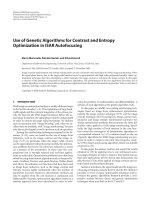
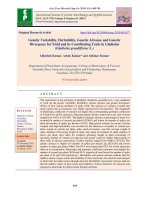
![Genetic analysis for micronutrients and grain yield in relation to diverse sources of cytoplasm in pearl millet [Pennisetum glaucum (L.) R. Br.]](https://media.store123doc.com/images/document/2020_01/13/medium_ion1578932058.jpg)

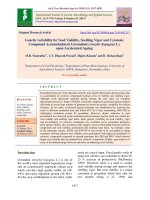
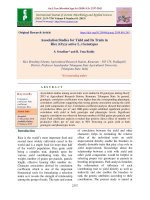

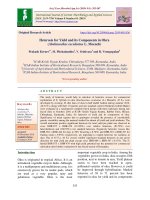
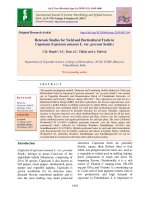
![Generation mean analysis using six parameters genetic model for quantitative traits in cowpea [(Vigna unguiculata (L.) Walp.]](https://media.store123doc.com/images/document/2020_01/14/medium_ccw1578956370.jpg)